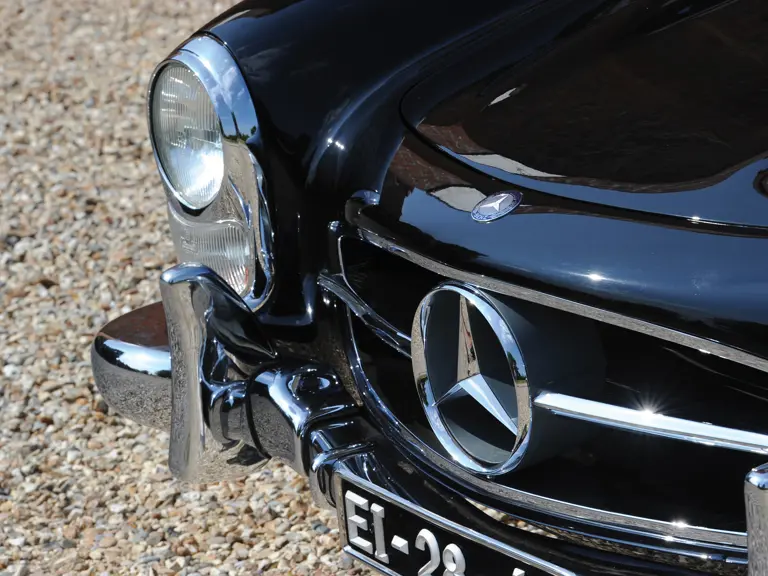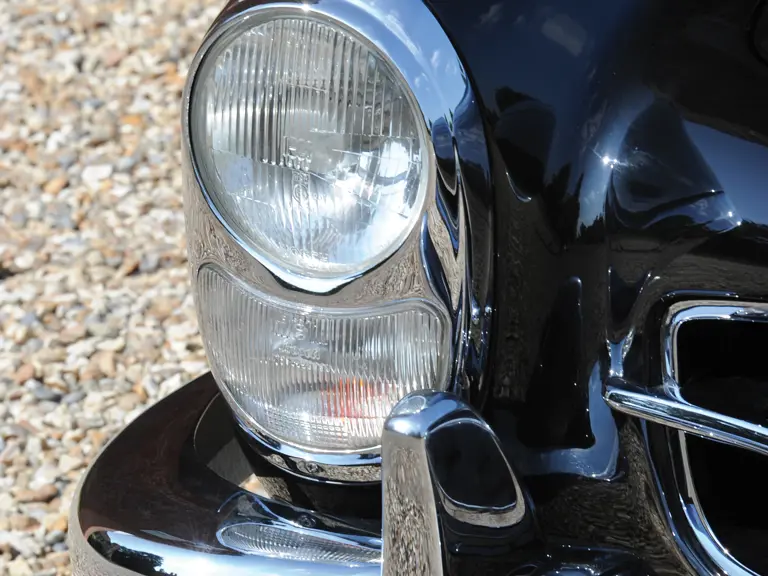215 bhp (DIN), 240 bhp (SAE), 2,996 cc overhead-cam inline six-cylinder engine, Bosch mechanical direct fuel injection, four-speed manual gearbox, independent front suspension with upper and lower A-arms and coil springs, independent rear suspension with coil springs and swing axles, and hydraulic front disc and rear drum brakes. Wheelbase: 2,400 mm
Few will disagree that the Mercedes-Benz 300 SL in both coupé and open form was the world’s most advanced, and perhaps the most beautiful, sports car produced by any firm in the 1950s. Many consider it to be the greatest sports car of all time. Its seeds were planted just a few years after the end of WWII, as Daimler-Benz began picking up what remained of its factories and started producing something besides trucks. Although the potential market was small, the company saw a need for an upscale automobile that was suitable for government and corporate dignitaries and the wealthy motorist. That car was the 300 series, which was offered in saloon and four-door convertible form, and it was introduced at the Frankfurt Auto Show in 1951. It proved a success and was soon joined by a luxurious coupé and cabriolet. The 300s were powered by a torquey, three-litre, overhead-cam inline six of very robust construction that hinted of further development potential. At the same time, the factory was thinking of a return to motorsports, and the big 300’s engine offered a good place to begin.
Chief Engineer Rudolf Uhlenhaut and his design team took aim at three-litre endurance sports car racing, and they soon produced the highly-advanced W194 coupé, which was based on a lightweight tubular space frame with an all-aluminium body shell and unique top-hinged doors; this resembled a bird’s spread wings when open, thus giving birth to the now-legendary “gullwing” label. Powered by an up-rated version of the company’s straight six laid over a 45-degree angle to reduce the car’s frontal aspect, the 300 SL, with “SL” standing for Sports Leicht, or Lightweight Sports, quickly proved its worth.
These exotic coupés swept the first two places in the sports class in the 1952 Carrera Panamericana road race after taking overall wins at Le Mans, Bern, and the Nürburgring. The factory team narrowly missed a victory at the Mille Miglia, settling for 2nd and 3rd overall. With these successes, there was an immediate clamour for the car to be made available to the public.
The first production coupé, now labelled the W198, was unveiled at the 1954 New York Auto Show, where it created a sensation. By then, the engine had been fitted with Bosch mechanical direct fuel injection, which was a first for the auto industry. This feature helped the engine produce an impressive 215 horsepower, and it made the very aerodynamic Gullwing Coupé the world’s fastest production automobile. Approximately 1,400 coupés were built and sold between 1955 and late 1957, with most of them being destined for American customers.
The original Mercedes-Benz 300 SL Gullwing Coupé made its exit in 1957, being succeeded by an open roadster model that debuted at that year’s Geneva Salon. Converting the famed racing-bred coupé to an open convertible meant dispensing with the famed upward-opening door and redesigning the chassis, which was strengthened significantly to compensate for the loss of the roof structure. Headlamps were changed, the grille was smaller, and chrome moulding was added below the doors. A new camshaft and higher compression boosted the famed, racing-derived, twin-cam, six-cylinder engine’s output to 225 brake horsepower, and its revised rear suspension now boasted a compensating spring, which was added to reduce the oversteering tendencies of the Gullwing’s single-jointed swing-axle arrangement.
Enthusiasts who may have worried about the 300 SL going “soft” had absolutely nothing to concern themselves about. The Roadster remained amongst the fastest automobiles on the road, as it was capable of 133 to 155 mph, depending upon the final drive ratio specified. Production continued into early 1963, and with 1,858 built, the Roadster proved even more popular than its Gullwing predecessor whilst still remaining exclusive enough to be rarely seen, and it was still incredibly powerful. Like the earlier coupé, it was, in its day, the car in which to see and be seen, and it was favoured by celebrities, racing drivers, and just about anyone who appreciated fine machinery and had the bank account to acquire it. As with all great automobiles, it has retained that same persona to this day, and it remains amongst the world’s most desired cars.
This 300 SL Roadster is a well-presented example that shows minimal wear from careful use and maintenance. As per factory information, it was originally delivered on 25 February 1961 in Ivory (OT 608) with a black top (UT 40) and red leather interior (1088). The sleek and sporty body has since been finished in black and shows no apparent orange peel; although, it would benefit from a light polishing to restore its shine. The exterior brightwork shows minor evidence of buffing, but it presents very well overall. The black cloth convertible top, in its original colour, displays light wrinkling from storage, but it remains in very good condition overall. To complete the package, a black removable hardtop, displaying minor chipping along the roof edge and some tarnishing of the aluminium trim from touring enjoyment, is included and presents as a sought-after addition. The 300 SL rides on chrome wheels with black paint-detailed chrome centre caps, which are both displaying minor patina from use, and they are shod in Dunlop tyres.
The well-sorted engine bay has benefitted from a thoughtful cosmetic restoration that included polishing the exhaust heat shield and chrome-plating the intake manifold. Most interesting is the presence of an alloy engine block in this car, which is stamped with the correct engine number. In fact, this car was produced only four numbers away from the “official” start of alloy block production, so it is possible that this was installed new from the factory, or upgraded very early on in the car’s life, after the new blocks became available. In addition, the air cleaner assembly, the coolant tank, and other ancillary components display paint detailing in gloss black, whilst plated components appear to be appropriately finished. This example also has front disc brakes, which are also believed to have been upgraded in period.
The interior, finished in beige leather, shows only minor wear from the previous owner’s enjoyment. The leather sill panels exhibit negligible soiling with no obvious blemishes. The headliner of the convertible top and the white perforated headliner of the hardtop both display minor staining from previous use, but they still appear in good condition overall. Black carpeting lines the boot, with newer fitted luggage adding to the grand touring image. Additionally, it features a period-correct Becker Europa radio. This 300 SL is a true sporting car, and it would be a welcome addition to any collection, as it offers spirited touring satisfaction.























 | London, United Kingdom
| London, United Kingdom



















